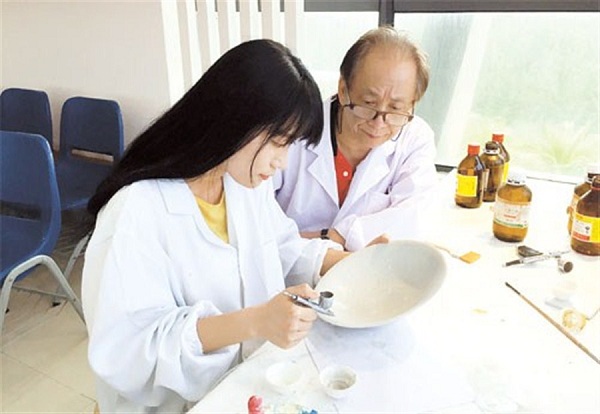
Jiang Daoyin (right) supervises his student, Zhou Yang, as she repairs one of the 800-year-old porcelain bowls from the Nanhai No 1.(Ti Gong)
Three teachers and 12 senior students from Shanghai Institute of Visual Arts yesterday finished restoring 15 800-year-old porcelain bowls at Maritime Silk Road Museum in Guangdong Province.
"It's the first time for college students to be invited to a museum to restore really precious cultural relics with such high historical and artistic value," said Jiang Daoyin, a famous ceramic repair specialist and a professor at Shanghai Institute of Visual Arts.
"It's a good chance for our students to practice the skills they have learned in the past four years before graduation, and also a chance to help the museum restore precious historical relics," said Jiang, leader of the team.
The bowls are only a small part of a collection of over 60,000 porcelain artifacts found in the Nanhai No 1 wooden ship, which sank in the South China Sea while sailing out to conduct trade along the Maritime Silk Road in the Southern Song Dynasty (1127-1279). It was salvaged in 2007, almost 20 years after it was discovered.
The ship loaded with pots, bottles, bowls and plates produced by famous kilns around China is considered an important research tool for academics studying the history of the Maritime Silk Road and Chinese porcelain.
The 15 bowls they repaired were made in a kiln in Dehua County in Fujian Province, which was famous for producing white porcelain for export.
"The porcelain artifacts were finely made art treasures. They were sold overseas because they represented the finest Chinese craftsmanship," said Jiang.
After being submerged in sea water beside ironware in the ship for 800 years, the porcelain bowls were etched with the red color of rust, and some broke when the ship sank.
They had to remove salt and rust from them first, then repair the broken parts and repaint them.
Easier said than done. Teachers and students spent almost a week discussing methods and carrying out experiments repeatedly to find the right solutions.
"We tried different detergents — from weak to strong — very gradually," said Zhou Yang, a student in the program. "We started with deionized water, then oxalic acid solution and potassium permanganate."
After that, they began to mend the broken parts with talcum powder and a special glue before polishing the surface and painting the bowls with ash-colored paint, returning them to their original condition.
Zhou said she was extremely careful because even the smallest damages to the bowl would be a failure and a loss to the country.


















































